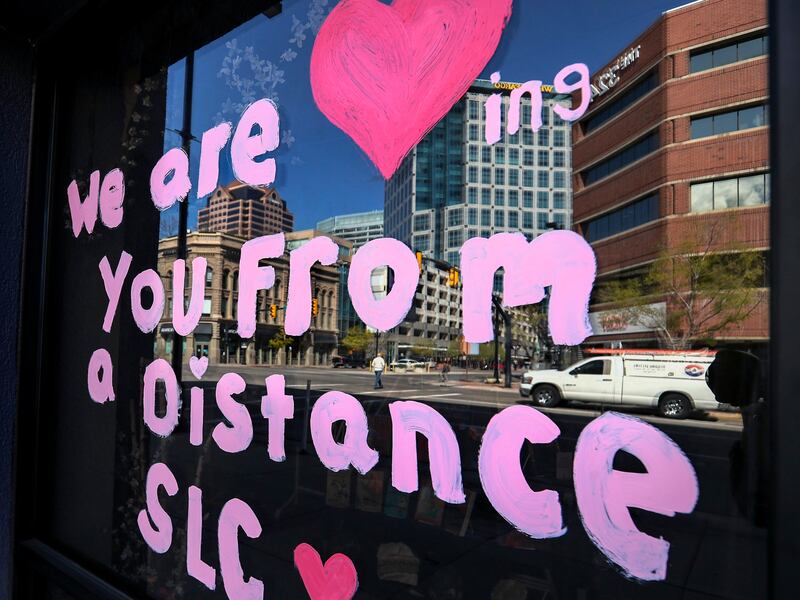SALT LAKE CITY — Arduous long hours, limited supplies, sick patients of all ages, loss and compassion.
Those are just a few of the things Utah Dr. Dixie Harris saw during her time volunteering in the nation’s COVID-19 hotspot in New York.
“The people here have, they’re the ones that, they really say it’s been five weeks of one continuous shift. Many people have taken a day off here and there, but are pretty much going to work every day,” she explained.
While Utah prepares for a potential uptick in cases of COVID-19 as social distancing measures loosen, area doctors who joined the battle against the virus in New York City are returning home.
During her two weeks overseeing nights in an intensive care unit at Northwell Health’s Southside Hospital in Bay Shore, a New York City suburb, Harris pulled repeated 13-hour shifts.
But the critical care physician who works in multiple Intermountain Healthcare hospitals in northern Utah says it’s just a glimpse of the experience of those there since the beginning.
As part of a group of 100 Intermountain Healthcare clinicians who volunteered to help out in New York in an exchange with health care systems there, Harris plans to bring the knowledge she gained to the Beehive State’s fight against COVID-19.

As of Saturday, three more residents have died with the disease, bringing the state’s death toll to 49, according to the Utah Department of Health. Two were from Utah County — one a woman older than 85 who died while hospitalized, and the other a man between the ages of 65 and 85. Officials did not know whether they had underlying health conditions.
The third fatality was a Salt Lake County resident older than 85 with underlying medical conditions.
In Utah, 153 more cases of COVID-19 were also confirmed, bringing the state’s total to 4,981 out of 117,804 tested. The positive rate remains about 4.2%, still lower than many surrounding states, health department officials reported.
State officials are hesitant to make predictions about when Utah might see its peak demand on the health care system. The Institute for Health Metrics and Evaluation now says the state could see its peak May 10.
“I will say that we’ve had time to prepare, which is fantastic,” Harris said.
In New York, the hospital where Harris worked typically has two intensive care units. When she arrived, an additional four units had been set up, bringing the need for more workers beyond the hospital’s capacity.
Community physicians have stepped in to fill that gap, she said, and the hospital has allowed doctors in their residencies to help as well.
“If you have to treat a markedly larger volume than you’re used to treating, you have to quickly adapt. And it’s everything from staffing and physical locality of where you’re taking care of patients, and then supplies. And I would say now some of the biggest challenges have been different supplies,” Harris said.
While she said the hospital has enough personal protective equipment, other essential supplies like the dressings health care workers use when they insert central lines into a patient are in short supply. Intensive care unit beds designed to move patients and recline are also limited — some patients have needed to be treated on gurneys, according to the doctor.
“The surge hit so quickly it’s not like they could say, ‘Hey, we’ve got a surge going on here at Utah Valley. So we’re going to call down to McKay-Dee Hospital, can you send these supplies?’” Harris explained.
Each hospital quickly became overwhelmed with COVID-19 patients.
“The ambulance could not bring patients in fast enough,” she explained.
But even with worker and supply shortages, Harris says the most challenging part of the virus is the inability to fully communicate, which she calls the “human part of medicine.”
Most patients have been intubated, she said, meaning they can’t talk. And the health care workers wear masks. Visitors also aren’t allowed.
The sense of loss throughout the city is also widespread, as everyone Harris met in New York lost a friend or relative to the disease. Some health care workers she met contracted it, recovered, and have since returned to work.
But the community has rallied around health care workers, Harris said. She received multiple care packages and notes of thanks.
While many feel the risk to them is low, as most of the fatalities have occurred in older adults, Harris urged Utahns to take the virus seriously.
The majority of her patients in the intensive care unit haven’t been older adults, as many older people have taken social distancing measures very seriously, Harris explained.
“A small, small percentage is hitting the youth, but it’s a numbers issue. So 1,000 youth — 20-year-olds get infected — and say this virus only makes a very small percentage sick or a very small percentage that dies from it. It’s still going to be significant,” Harris said.
“So if it’s only 2%, that’s 20 20-year-olds. I respect this disease. I respect the different ways it manifests. And I don’t think anybody is really completely safe from this disease.”
The breakdown of Utah COVID-19 cases, hospitalizations and deaths by health district:
- Salt Lake County, 2,609; 243 hospitalized; 30 deaths.
- Utah County, 1,021; 51 hospitalized; 9 deaths.
- Summit County, 375; 33 hospitalized; 0 deaths.
- Davis County, 296; 23 hospitalized; 2 deaths.
- Weber-Morgan, 166; 20 hospitalized; 2 deaths.
- Wasatch County, 156; 7 hospitalized; 1 death.
- Southwest Utah, 103; 13 hospitalized; 2 deaths.
- Tooele County, 69; 6 hospitalized; 0 deaths.
- Bear River, 61; 10 hospitalized; 1 death.
- San Juan County, 78; 10 hospitalized; 2 deaths.
- Central Utah, 23; 1 hospitalized; 0 deaths.
- TriCounty (Uinta Basin), 13; 1 hospitalized; 0 deaths.
- Southeast Utah, 11; 0 hospitalized; 0 deaths


